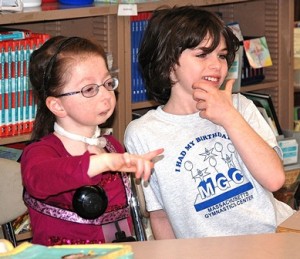By Ed Karvoski Jr., Contributing Writer

Northborough – At the beginning of this school year, families of fourth-graders at Proctor Elementary School received a letter from Principal Margaret Donohoe, announcing the hope to form a sign language group.
“One of the students involved would like to practice her sign language as she interacts with other children here at school,” she wrote.
Parents returned a brief form, indicating whether their child has permission to attend the group. Helene Desjardins, the school's speech and language pathologist, said nearly all families expressed interest in participating.
“The response was overwhelming,” she said.
Now the group is helping fourth-graders interact with their classmate Julia Cobb, who is a multimodal communicator.
“She has some vocalizations and she uses sign,” Desjardins explained. “She also has access to communication devices, the DynaVox and an iPod Touch.”
When Julia started kindergarten at Proctor School, teachers learned to incorporate sign language in classrooms with lessons and songs.
“Students in her class were very interested in learning to sign from watching what she was doing,” Desjardins said. “They picked it up very quickly, and they carried it on into the first grade.”
While Julia was in the second grade, sign language was included in a weekly 30-minute class instructed by Donna Sarti, who works as a sign consultant in the district.
Sarti recalled her first impression of Julia.
“Julia was so full of excitement,” she said. “She danced around as she showed me the school. Her personality fits signing because she uses her whole body to communicate.”
The sign instruction with Sarti continued in the third grade, and so did the students” enthusiasm, noted Desjardins.
“It really took off in the third grade with the kids really wanting to be involved and learn more complicated signs,” she said. “We moved from signing simple songs to now, when I think the whole fourth grade can sign the Pledge of Allegiance.”
With the general education requirements increasing in the fourth grade, the sign instruction has moved from the classroom to lunchtime. A small, 30-minute group meets Wednesdays for several weeks. Rotating groups will meet throughout the school year.
“An advantage of a small group is that I's able to give more individual attention to students,” Sarti said. “And I think Julia participates more in the smaller groups.”
Desjardins has observed that Julia and her classmates have integrated lessons learned from the signing instruction into their daily routines.
“If Julia is coming down the hall and sees someone, she's very quick to sign to them because it's definitely her preferred method of communication,” she said. “And to see the other kids really want to be involved in that, I think is very empowering for her. They'se getting older and their friendships are really evolving. It helps them to be able to communicate with her.”
Julia's mother, Christine, has seen the friendships evolve firsthand.
“There are a few kids who have been with Julia since kindergarten,” Christine said. “We have play dates with them and they do understand a lot of her signing. I think without the signing in the school, then that would never have happened.”
Christine believes the group is beneficial for everyone involved.
“It gives the other kids an opportunity to see how somebody might learn differently, and the added benefit is that they'se learning a new skill,” she said. “They don's see signing as being anything different. To them, it is what it is, and Julia is Julia – that's how they'se always known her. She might sign to you, or she might tap it out on her iPod. One way or the other, she gets her point across.”
















